CHEVROLET MONTE CARLO 1981 4.G Manual PDF
Manufacturer: CHEVROLET, Model Year: 1981, Model line: MONTE CARLO, Model: CHEVROLET MONTE CARLO 1981 4.GPages: 104, PDF Size: 23.92 MB
Page 71 of 104
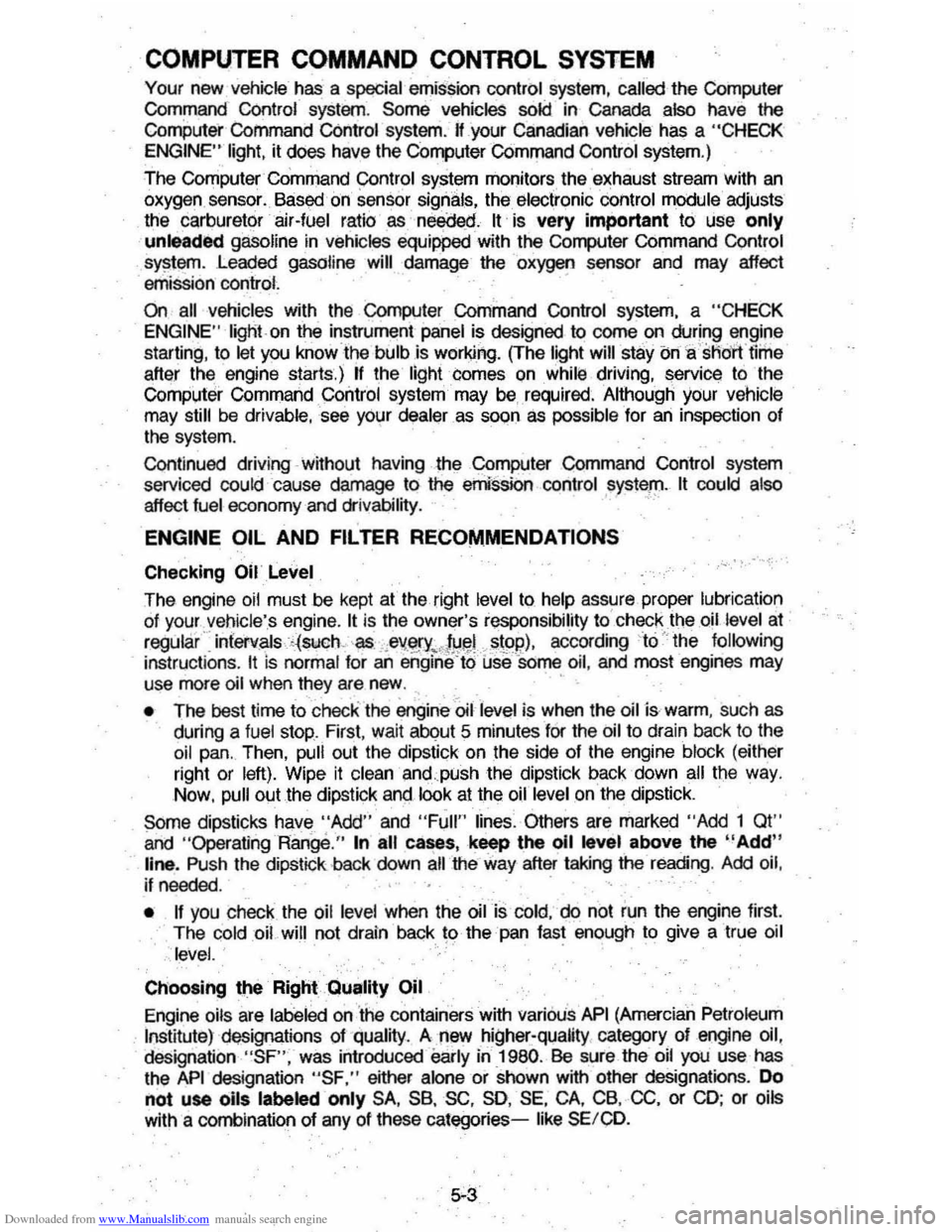
Downloaded from www.Manualslib.com manuals search engine COMPUTER COMMAND CONTROL SYSTEM
Your new vehicle has a special emission contrOl system, called the Computer
Command Control system. Some vehicleS sold in Canada also have the
Computer Command Control system. II your Canadian vehicle has a "CHECK
ENGINE" light,
it dOes have the Computer Command Control system.)
The Computer Command Control system monitors . the .exhaust stream with
an
oxygen sensor. Based on sensor signals, the electronic control module adjusts
the carburetor air-fuel ratio as needed. It is very important to use only
unleaded gasoline in vehicles equipped with the Computer COmmand Control
system . .Leaded gasoline will damage the oxygen sensor and may affect
. emission controL .
On
all vehicles with the COmpute r Command Control system, a "CHECK
ENGINE" ligtit
on the instrument panel is designed to come on during engine
starting, to
let you knowthe bulb .is working. (The light will stay on a'shdl1iime
after the. engine starts.) If. the light comes on while driving, service to the
Computer Command Control system may be. required. Although your vehicle
may
still be drivable,see yoyr dealer as SOon as possible for an inspection of
the system.
Continued
driving · Without having the Computer Command Control system
serviced could cause damage to the emiSsion control system. It could also aftect fuel economy and drivability. .. ..
ENGINE OIL AND FILTER RECOMMENDATIONS
Checking 011 Level ,>,-.. ,
The engine oil must be kept at the right level to. help assure proper lubrication
of your vehicle' .s engine.
It is the owner's responsibility to' cheCk the oil level at
regular': infervals '{such . 'as . "e~~Y"JHflLstop), according ·to ' the following instruct ions . It is normal for an engine-O to use Some oil, and most engines may
use
more oil when they are new . " .
• The best time to check' the engine Orffevel is when the oil IS warm, such as
during a
fuel stop. First, wait about 5 minutes for the oil to drain back to the oil pan. Then, pull out the dipstick on the side of the engine block (either
right or left). Wipe
it clean and. push the dipstick back down all the way.
Now,
pull out the dipstick and look at the oil level .on the dipstick.
Some dipsticks have "Add" and "Full" lines. Others are marked "Add lOt"
and "OperatlngRange ." In all cases, keep the oil level above the "Add" line_ Push the dipstick .oock down alilheway after taking the reading . Add oil , if needed . . .
• If you check the oil level when the oil is cold, do not iun the engine first.
The
cold oil will not drain back to the pan fast enough to give a tr ue oil
level. . .
Ch '
oosing the Right Quality on
Engine oils are labeled on'the containers with variOus API (Amercian Petroleum Institute) deSignations of·quality. Artewhigher-quality category of engine 011,
designation "SF", was introduced early in 1980. Be sure the oil you use has
the
API designation "SF," either alone or shown with other designations . Do not use oils labeled only SA, SB,SC, SO,' SE, CA, CB,CC, or CD; or oils
with a combination of any of these categories-like SE/CD.
5-3
Page 72 of 104
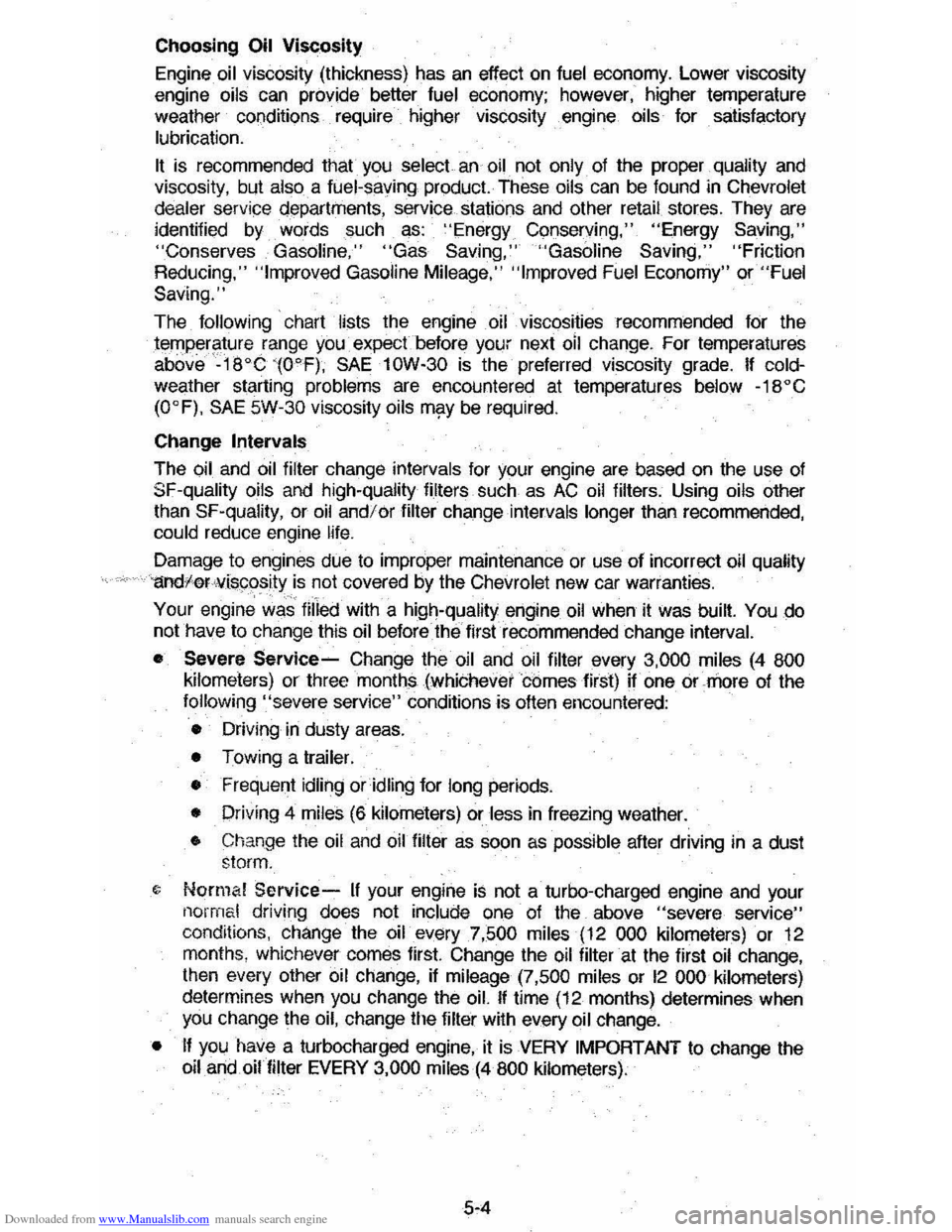
Downloaded from www.Manualslib.com manuals search engine Choosing Oil Viscosity
Engine oil viscosity (thickness) has an effect on fuel economy. Lower viscosity engine oils can provide· better fuel economy; however, higher temperature
weather cOl1ditions. require· higher viscosity .engine. oils· for satisfactory
lubrication.
It is recommended that you select an oil not only of the proper quality and
viscosity, but also. a fuel-saving product.· These oils can be found in Chevrolet dealer serviGe departments, service stati()ns and other retail stores. They are
identified by words such as: "Energy Conserving," "Energy Saving," "Conserves Gasoline," "Gas Saving," "Gasoline Saving," "Friction
Reducing," "Improved Gasoline Mileage," "Improved Fuel Economy" or "Fuel
Saving."
The following chart lists the engine oil viscosities recommended for the
tE3lT1per~ture range you·. expecLbefore your next oil change. For temperatures
above -18'C '(O'F), SAE 10W-30 is the preferred viscosity grade. If coldweather starting problems are encountered at temperatures below -18'C
(O'F), SAE 5W-30 viscosity oils m?-y be required.
Change Intervals
The oil and oil filter change intervals for your engine are based on the use of SF-quality oils and high-quality filters such as AC oil filters. Using oils other
than
SF-quality, or oil and/or filter change intervals longer than recommended, could reduce engine life.
Damage to engines due to improper maintenance or use of incorrect oil quality
'andl0r"'vi$9()~ity}s .~ot covered by the Chevrolet new car warranties.
Your engine WEIS filled with a high-quality engine oil when it was built. You do
not have to change this oil before the first recommended change
interval.
•
Severe Service-Change the oil and oil filter every 3,000 miles (4 800
kilometers) or three months (whichevefcbmes first) if one or more of the following "severe service" conditions is often encountered:
• Driving in dusty areas.
• Towing a trailer.
• Frequent idling or idling for long periods.
• Oriving 4 miles (6 kilometers) or less in freezing weather.
• Change the oil and oil filter as soon as possible after driving in a dust storm.
~ Norma! Service-If your engine is not a turbo-charged engine and your
normal driving does not include one of the above "severe service" conditions, change the oil every 7,500 miles (12 000 kilometers) or 12
months, whichever comes first. Change the oil
filter at the first oil change,
then every other
oil change, if mileage (7,500 miles or 12 000 kilometers)
determines when you change the oil. If time (12 months) determines when
you change the oil, change the filter with every oil change.
• If you have a turbocharged engine, it is VERY IMPORTANT to change the
oil and oil filter EVERY 3,000 miles (4 800 kilometers).
5-4
Page 73 of 104
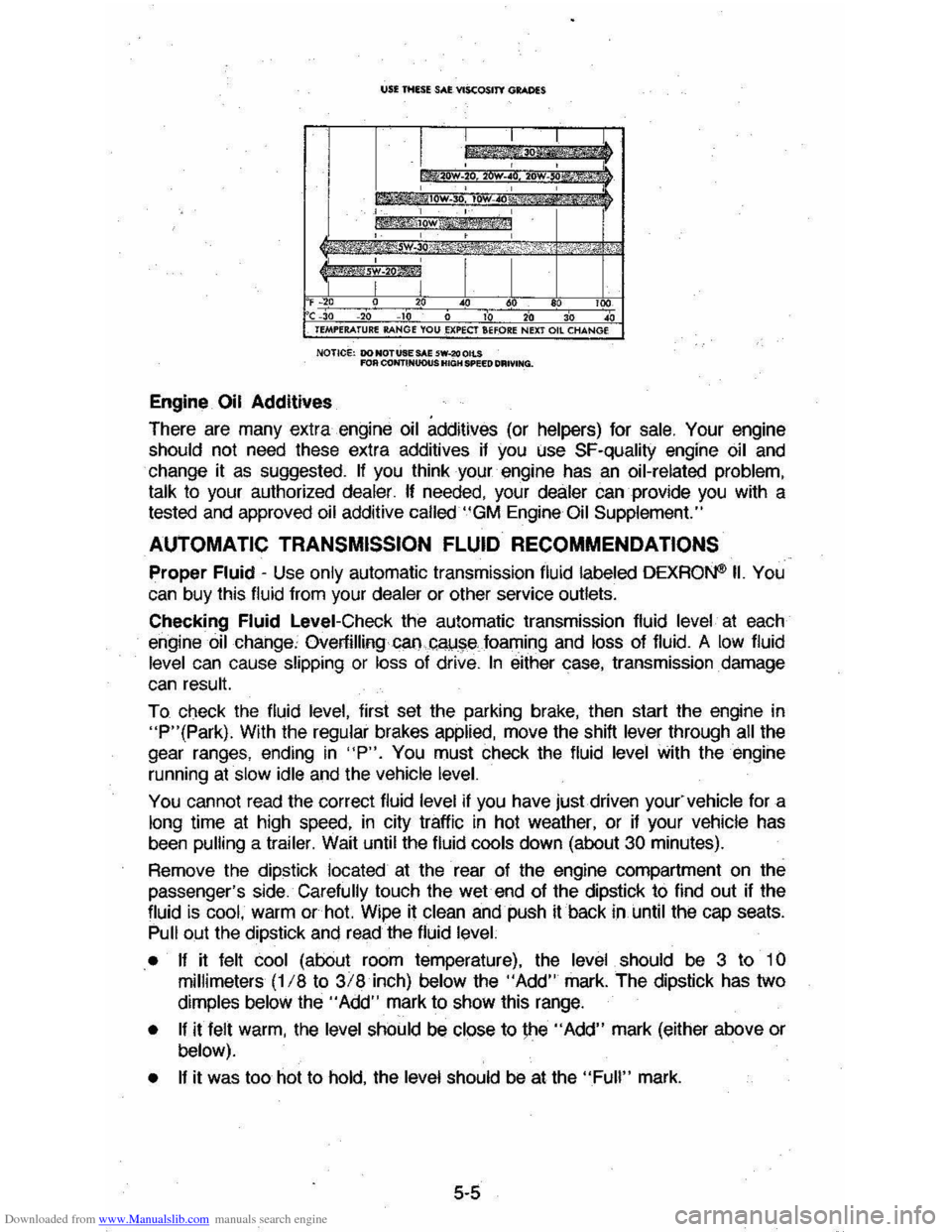
Downloaded from www.Manualslib.com manuals search engine un mUE SAl: VIScOSITY GRADES
F~O 20 40 60 100 C -30 -20 10 0 10 20 30 40 TEMPERATURE RANGE YOU .EXPECT SHORE NEXT Oil CHANGE
NOTICe: DO NOTUSE SAE 5W-2(I OILS fOR COIfi"INUOUS HIGH SPEED DRIVING.
Engine Oil Additives
There are many extra engine oil additives (or helpers) for sale. Your engine
should not need these extra additives if you Use SF-quality engine oil and
change it as suggested. If you think your engine has an oil-related problem,
talk
to your authorized dealer. If needed, your dealer can provide you with a
tested and approved oil additive called "GM Engine Oil Supplement."
AUTOMATIC TRANSMISSION FLUID RECOMMENDATIONS
Proper Fluid -Use only automatic transmission fluid labeled DEXRON® II. You
can buy this fluid from your dealer or other service outlets.
Checking
Fluid Level-Check the automatic transmission fluid level at each
engine
oil change, Overfilling GaI).c"!,J~e foaming and loss of fluid. A low fluid
level can cause slipping or loss of drive. In either case, transmission damage
can result.
To check the fluid
level, first set the parking brake, then start the engine in "P"(Park). With the regular brakes applied, move the shift lever through all the
gear ranges, ending
in "P". You must check the fluid level with the engine
running
at slow idle and the vehicle level.
You cannot read the correct fluid level if you have just.driven you(vehicle fora
long time at high speed, in city traffic in hot weather, or if your vehicle has
been
pulling a trailer. Wait until the fluid cools down (about 30 minutes).
Remove the dipstick
located at the rear of the engine compartment on the
passenger's side. Carefully touch the wet end of the dipstick to find out if the
fluid
is cool, warm or hot. Wipe it clean and push it back in until the cap seats. Pull out the dipstick and read the fluid level.
• If
it felt cool (about room temperature), the level should be 3 to 10
millimeters (118 to 3/8 inch) below the "Add" mark. The dipstick has two
dimples below the" Add" mark to show this range.
• If it felt warm, the level should be close to \he "Add" mark (either above or below).
• If
it was too hot to hold, the level should be at the "Full" mark.
5-5
Page 74 of 104
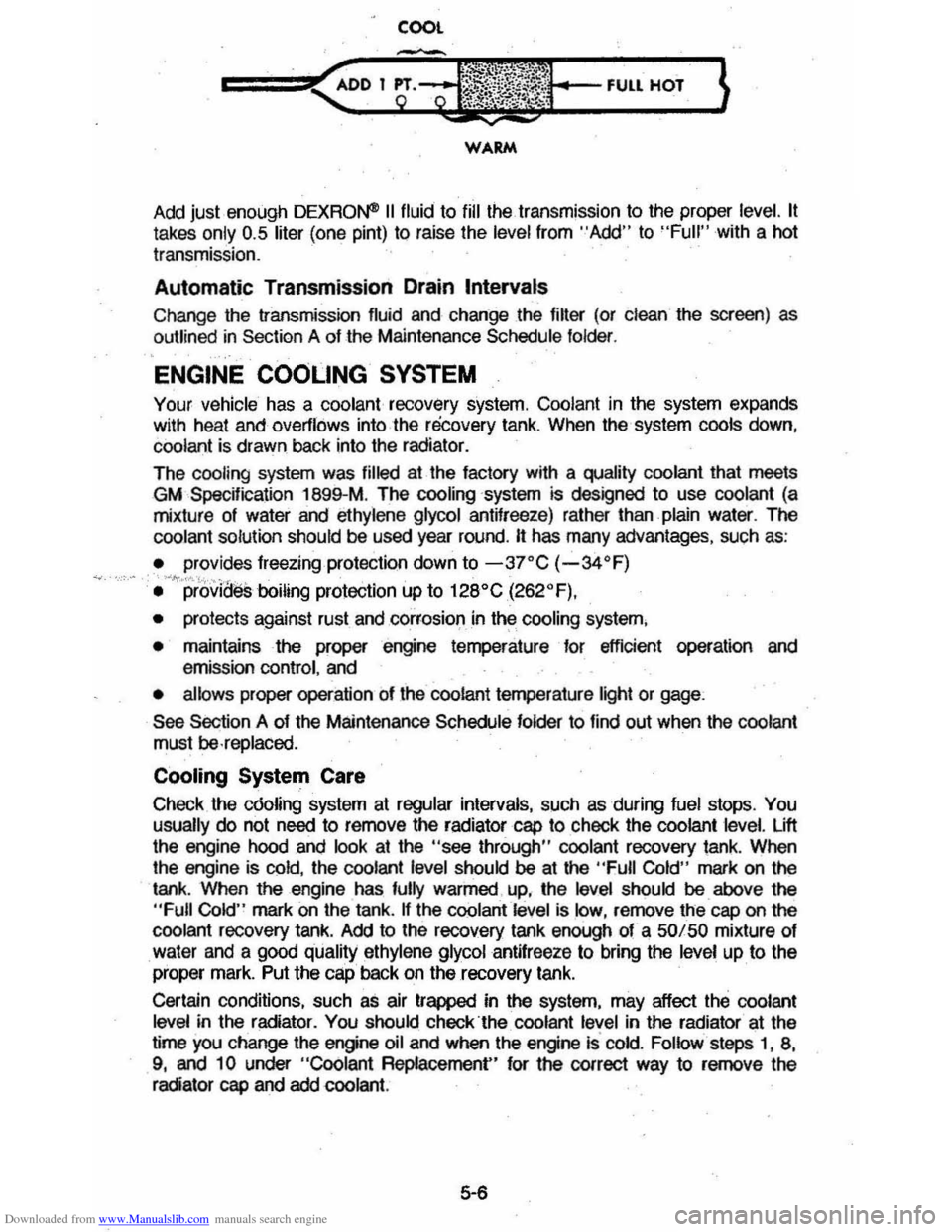
Downloaded from www.Manualslib.com manuals search engine COOL
WARM
Add just enough DEXRO~ II fluid to fill the transmission to the proper level. It
takes only 0.5 liter (one pint) to raise the level from "Add" to "Full" with a hot
transmission.
Automatic Transmission Drain Intervals
Change the transmission fluid and change the filter (or clean the screen) as
outlined
in Section A of the Maintenance Schedule folder.
ENGINE COOLING SYSTEM
Your vehicle has a coolant recovery system. Coolant in the system expands
with heat and overflows into the recovery tank. When the system cools down,
coolant is drawn back into the radiator.
The cooling system was
filled at the factory wrth a quality coolant that meets
GM
Spec~ication 1S99-M . The cooling ·system is designed to use coolant (a
mixture of water and ethylene glycol antifreeze) rather than plain water. The
coolant solution should be used year round.
It has many advantages, such as:
~ provides freezing protection down to -3rC (-34"F) "''''''<~. !'"","."" ' • provides boiling protection up to 12S"C (262"F),
• protects against rust and corrosio~in th~ cooling system,
• maintains the proper engine temperature for efficient operation and
emission control, and
• allows proper operation of the coolant temperature light or gage :
See Section A of the Maintenance Schedule folder to find out when the coolant
must
be ·replaced.
Cooling System Care
Check the c60ling system at regular intervals, such as during fuel stops . You usually do not need to remove the radiator cap to check the coolant level. Lift
the engine hood and look at the "see through" coolant recovery tank. When
the engine is
cold, the coolant level should be at the "Full Cold" mark on the
tank . When the engine has fully warmed . up, the level should be above the
"Full Cold" mark on the tank . If the coolantl6vel is low, remove the cap on the
coolant recovery tank. Add to the recovery tank enough of a 50/50 mixture of
water and a good quality ethylene glycol antifreeze to bring the
level up to the
proper mark. Put the cap back on the recovery tank.
Certain conditions, such
as air trapped in the system, may affect the coolant
level in the radiator. You should check"the coolant level in the radiator at the
time you change the engine
oil and when the engine Is cold. Follow.taps I, S,
9, and 10 under "Coolant Repfacement" for the correct way to remove the
radiator cap and add coolant.
5-6
Page 75 of 104
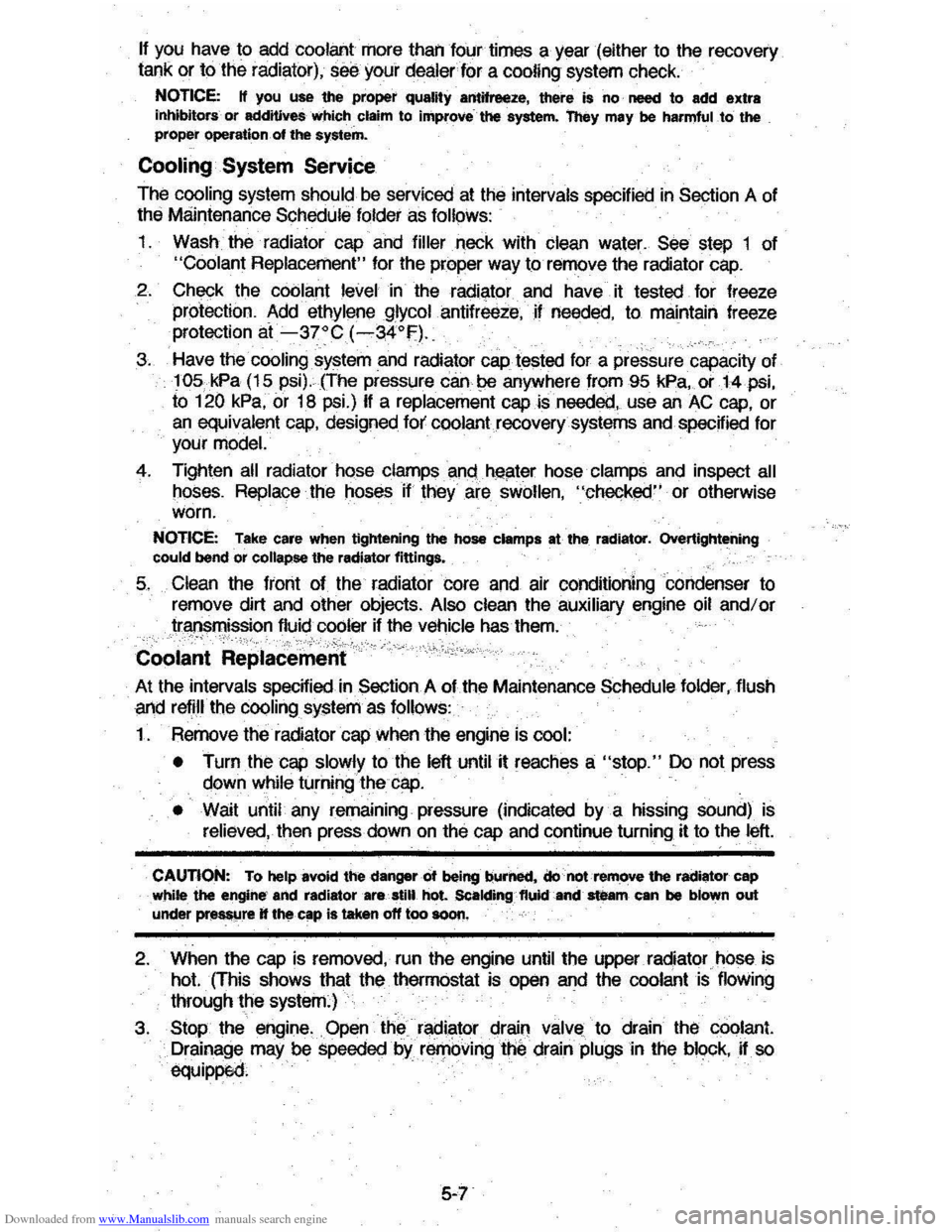
Downloaded from www.Manualslib.com manuals search engine If you have to add coolant more than four times a year (either to the recovery
tank or to the radiator), see your dealer for a cooling system check.
NOTICE: If you use the proper quality antifreeze, there is no· need to add extra inhihitorsor additiveswtlich claim to improve-the system. They may be harmful to the proper operation of the system.
Cooling' System Service
The cooling system should be serviced at the intervals specified in Section A of
the Maintenance Schedule folder as follows:
1. Wash the radiator cap and filler neck with clean water. See step 1 of "Coolant Replacement" for the proper way to remove the radiator cap.
2. Check the coolant level in the radiator and have it tested for freeze
protection.
Add ethylene glycol antifreeze, if needed, to maintain freeze
protection at-3JOC (~$4°f).
3. Have the cooling system and radiator cap tested for a pressure capacity of 105. kPa (15psi). (The pressure cantle anywhere from 95 kPa, or 14 psi,
to 120
kPa, or 18 psi.) If a replacement cap is needed, use an AC cap, or
an equivalent cap, designed fof coolant recovery systems and specffied for
your model.
4. Tighten all radiator hose clamps ang heater hose clamps and inspect all
hoses. Replace the hOSes if they are swollen, "checked" or otherwise worn.
NOTICE: Take care when tightening the hose clamps at the radiator. Overtightening could bend or collapse the radiator fittings.
5. Clean the front of the radiator core and air conditioning condenser to
remove dirt and other objects. Also clean the auxiliary engine oil andlor
transmission fluid cooler if the vehicle has them.
Coolant Replacernent
At the intervals specffied in Section A of the Maintenance Schedule folder, flush
9r1d refill the cooling system as follows:
1. Remove the radiator cap when the engine is cool:
•
Turn the cap slowly to the left until it reaches a "stop." Do not press
down while turning the
cap.
• Wait until any remaining pressure (indicated by a hissing sound) is
relieved, then press down on the cap and continue turning it to the left.
CAUTION: To help avoid the dangarm being burned. donotrem_ove the radiator cap While the engine' and radiator are. still. hot. Scaldingftukland steam ean be blown out under ~re It the cap is taken off too SOOf1.
2. When the cap is removed, run the engine until the upper rad.iator hose is
hot.
(ThiS shows that th~ thermostat is open and the coolant is flowing
through the system.)
3. Stop the engine. Open Ihe,actialor drain valVE! to drain the coolant. Drainage may be speeded by removing the drain plugs in the block, ff so
equipped.
5-7
Page 76 of 104
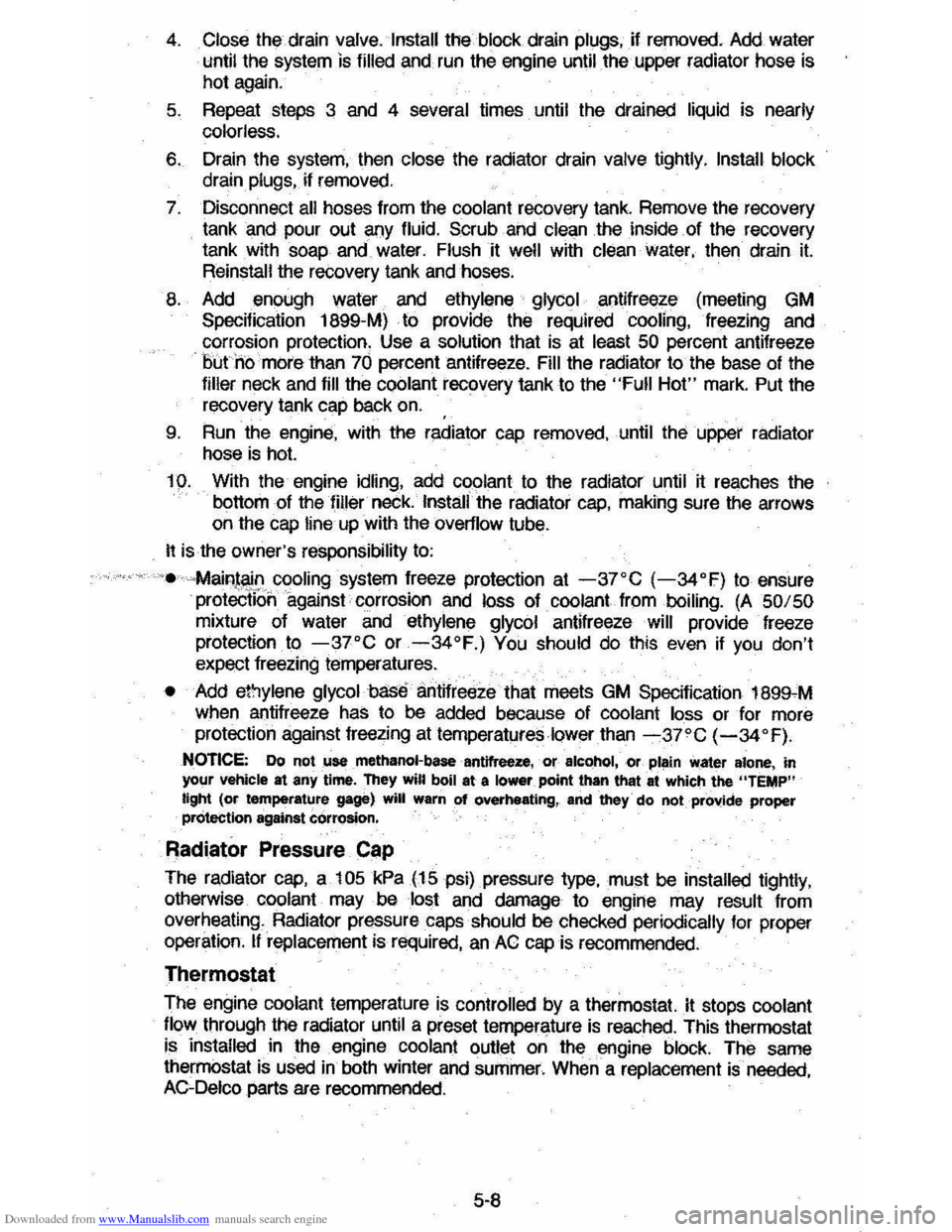
Downloaded from www.Manualslib.com manuals search engine 4. Close the drain valve. Install the block drain plugs, if removed. Add water
until the system is
filled and run the engine until the upper radiator hose is
hot
again.
5. Repeat steps 3 and 4 several times until the drained liquid is nearly colorless.
6. Drain the system, then close the radiator drain valve tightly. Install block
drain plugs, if removed.
7. Disconnect all hoses from the coolant recovery tank. Remove the recovery
tank
and pour out any fluid. Scrub and clean the inside of the recovery
tank with soap and water. Flush it well with clean water, then drain it.
Reinstall the recovery tank and hoses.
8. Add enough water and ethylene glycol antifreeze (meeting GM
Specification 1899-M) to provide the required cooling, freezing and
c()rrosion protection, Use a solution that is at least 50 percent antifreeze out no mOre than 70 percent antifreeze. Fill the radiator to the base of the
filler neck
and fill the coolant recovery tank to the "Full Hot" mark. Put the
recovery tank cap back on.
9. Run the engine, with the radiator cap removed, until the upper radiator
hose is hot.
10. With the engine idling, add coolant to the radiator until it reaches the
bottom of the filler neck. Install the radiator cap, making sure the arrows on the cap line up with the overflow tube.
iI is the owner's responsibility to,
'. -Main)!!!n cooling system freeze protection at -3rC (-34'F) to ensure protection against corrosion and loss of coolant from boiling. (A 50/50
mixture of water and ethylene glycol antifreeze will provide freeze
protection to -37'C or -34'F.) You should do this even if you don't
expect freezing temperatures.
• Add ethylene glycol base' antifreeze that meets GM Specification 1899-M
when antifreeze haS to be added because of coolant loss or for more
protection against freezing at temperatures lower than -37'C (-34'F).
NOTICE: Do "otute methanol-base antifreeze, Of alcohol,or plain water alone, in your vehicle at any time. They will boil at a lower point than that at which the "TEMP"
light (or temperature gage) will warn of overheating,. and they do not provide proper protection against cOrrosion.
Radiator Pressure Cap
The radiator cap, a 105 kPa (15 psi) pressure type, must be installed tightly,
otherwise coolant may be lost and damage to engine may result from
overheating. Radiator pressure
caps should be checked periodically for proper
operation. If replacement is required, an AC cap is recommended.
Thermostat
The engine coolant temperature is controlled by a thermostat. It stops coolant
flow
through the radiator until a preset temperature is reached. This thermostat
is installed in the engine
coolant outlet on the engine block. The same thermostat is used in both winter and summer. When a replacement is needed, AC"Delco parts are recommended.
5-8
Page 77 of 104
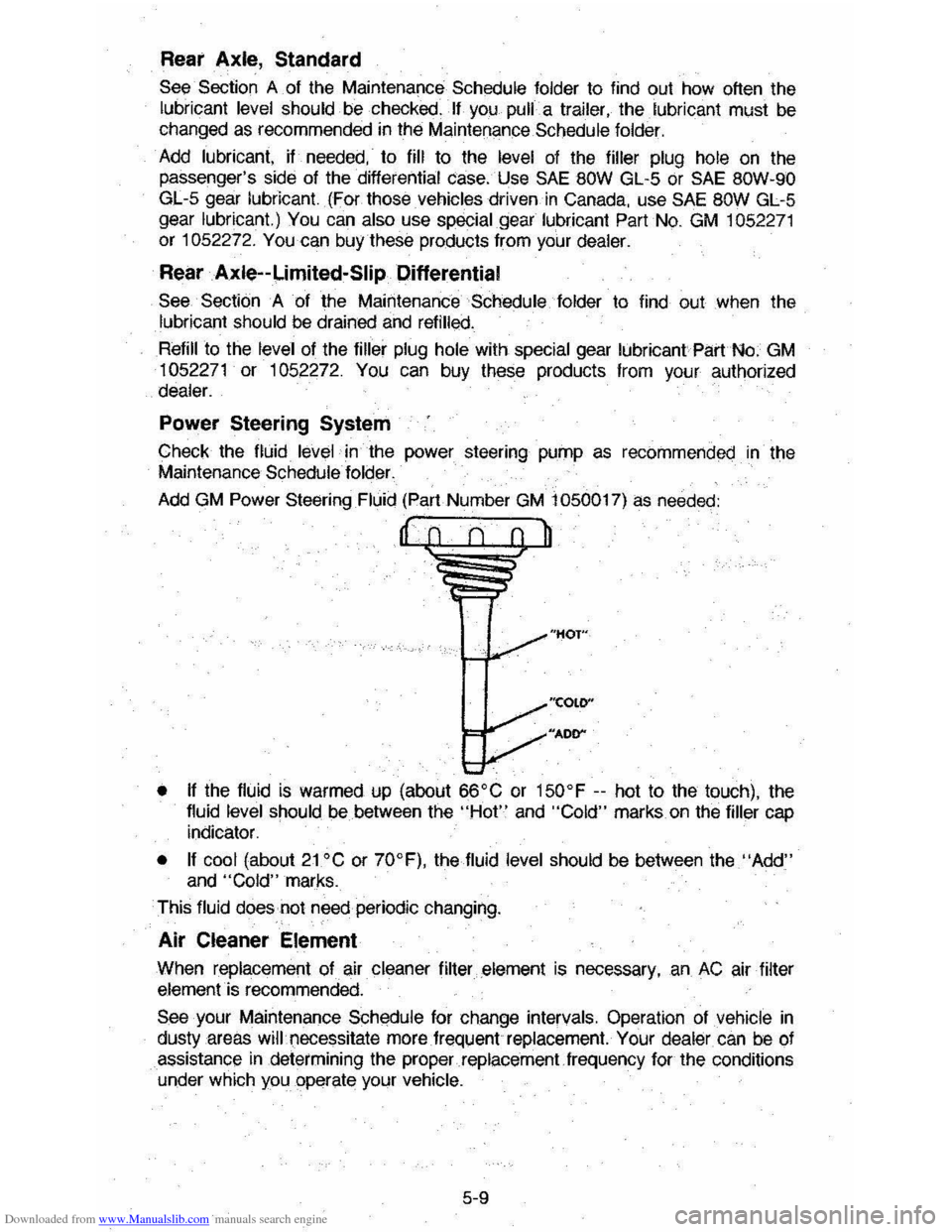
Downloaded from www.Manualslib.com manuals search engine Rear Axle, Standard
See Section A of the Maintenance Schedule folder to find out how often the
lubricant level should be checked. If you pull a trailer, the lubricant must be changed as recommended in the Maintenance.Schedule folder.
Add lubricant, if needed, to fill to the level of the filler plug hole on the
passenger's side of the
differential case. Use SAE BOW GL-S or SAE BOW·90
GL-S gear lubricant. (For those vehicles driven in Canada, use SAE BOW GL-S gear lubricant.) You can also use special gear lubricant Part No. GM 10S2271
or 10S2272. You can buy these products from your dealer.
Rear Axle--!-imited-Slip Differential
See Section A of the Maintenance Schedule folder to find out when the lubricant should be drained and refilled.
Refill to the level of the filler plug hole with special gear lubricant part No. GM
1052271 or 10S2272. You can buy these products from your authorized dealer.
Power Steering System
Check the fluid level in the power steering pump as recommended in the
Maintenance Schedule folder.
Add GM Power Steering Fluid (Part Number GM 1 OSOOI7) as needed:
"HOT"
"COLO"
"ADD"'"
• If the fluid is warmed up (about 66'C or IS0'F --hot to the touch), the
fluid level should be between the "Hot" and "Cold" marks on the filler cap
indicator.
• If cool (about 21 'C or 70'F), the fluid level should be between the "Add" and "Cold" marks.
This
fluid does not need periodic changing.
Air Cleaner Element
When replacement afair cleaner filter.;element is necessary. an AC air filter element is recommended.
See your Maintenance Schedule for change intervals. Operation of vehicle in
dusty areas will',necessitate more.frequentreplacernent.' Your dealer. can be of
assistance in determining the properreplacement.frequency for the conditions under which you operate your vehicle.
S-9
Page 78 of 104
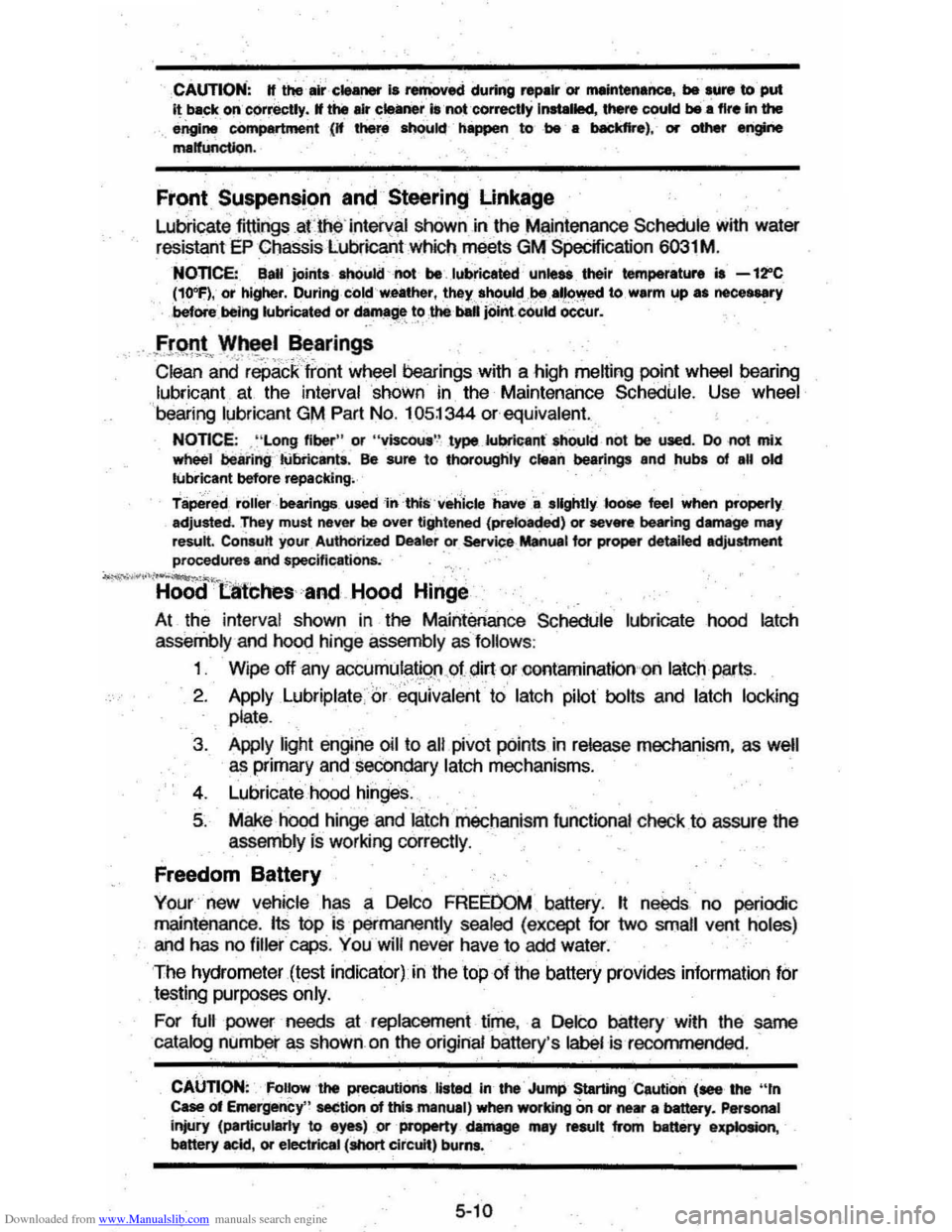
Downloaded from www.Manualslib.com manuals search engine CAUTION': It" the alr 'l;lMner i, ren;oveci during repair or maintenance, bel"'re to put H bl,ck on'eQr~ctly. It the air cleilner Is 'not correctly Inltalled. there could bea fire in the engine compertment (It there ~Id h..,.,en to be a backfire) , or other engitie mallunc1lon .
Front Suspension and Steering Linkage
Lubric;lte fi tngsatlhEj ' intery;>1 showninthe Maintenance Schedule with water
resistant
EP Chassis lUb(icantwhich meets GM SpecifICation 6031M.
NOTICE: ,Ball ' joints, should "not be . lubrieak.d unlesS, their temperature il -12"C (10"f},or higher,During ,coldweather, theyahould" .. ~"al,)c)~ to,warm up al nece ... ry ,before being lubricated or damttge to the baH jOint-Could occur. . , ' '.' "
.. ,. fIRnl 'N. c~~~arings
Clean and repack front wheel bearings with a high melting point wheel bearing
lubricant . at the interval shown in the Maintenance Schecule. Use wheel
' bearing lubricant GM Part No. 10 5~ 344 or equivalent.
NonCE: ," Long fiber " or "vbeou.'-' type"iubricenf ~kI nol be used, Do not mix wheel ~irinQ"lUbricant., Be sure to thoroughly c5aan bearings and hubl of all old lubricant before repacking.
Tapered roller,bearings uaed'h'Hhis 'veh icle have' .. sUghtly looSe teel when properly adjusted, They must never ~ over tightened (preJoaded) or sev .... bearing damage may resuit. Con.utt your,Authorized Deektr or Servi<:e.r.enual tor peper detailed adjustment procedures and specifications. . '~". :...,"" .... ~"";~f>"'~"'-"'''''',','',' ,::, Hood tlltchesand.Hood Hinge
At the interva l shown in the Maintenan ce Schedule lubricate hood latch
assembly
and hood hinge assembly as follows :
1. Wipe off any accumul"ti~!).ofqirt Qfoontaminationon latch Pi1!'ts.
2. Apply Lubriplate . or equivalent to latch pilot bolts and latch locking
plate .
3. Apply light engine oil to all pivot paints in release mechanism, as well
as primary and Secbndary latch mechanisms.
4. Lubricate hood hinges .
5~ Make hood hinge and latch mechanism functional check to assure the assembly is working COfTectiy.
Freedom Battery
Your new vehicle has a Delco FREEOOM battery. It neecs . no periodic
maintenance .
Its top is permanently sealec (except for two small vent holes) and has no filler capS. You will never have to add water.
The hydrometer (test indicator) in the top of the battery provides information for
testing purposes only.
For full power needs at replacement time, a Delco battery wijh the same catalog number as shown on the original battery's labe l is recommended ..
CAUTIQN: ",' FOllOW the precautions listed in the' Jump Starting ' 'Caution (see ' Ihe "In Case of EmergenCy " settlon of this manual) when workmg On or 08. a bMtery. Personal Injury {particularly to eyea} or 'property damage may result from battery e~ battery acid, or electrical (short circuit) burns.
5-10
Page 79 of 104
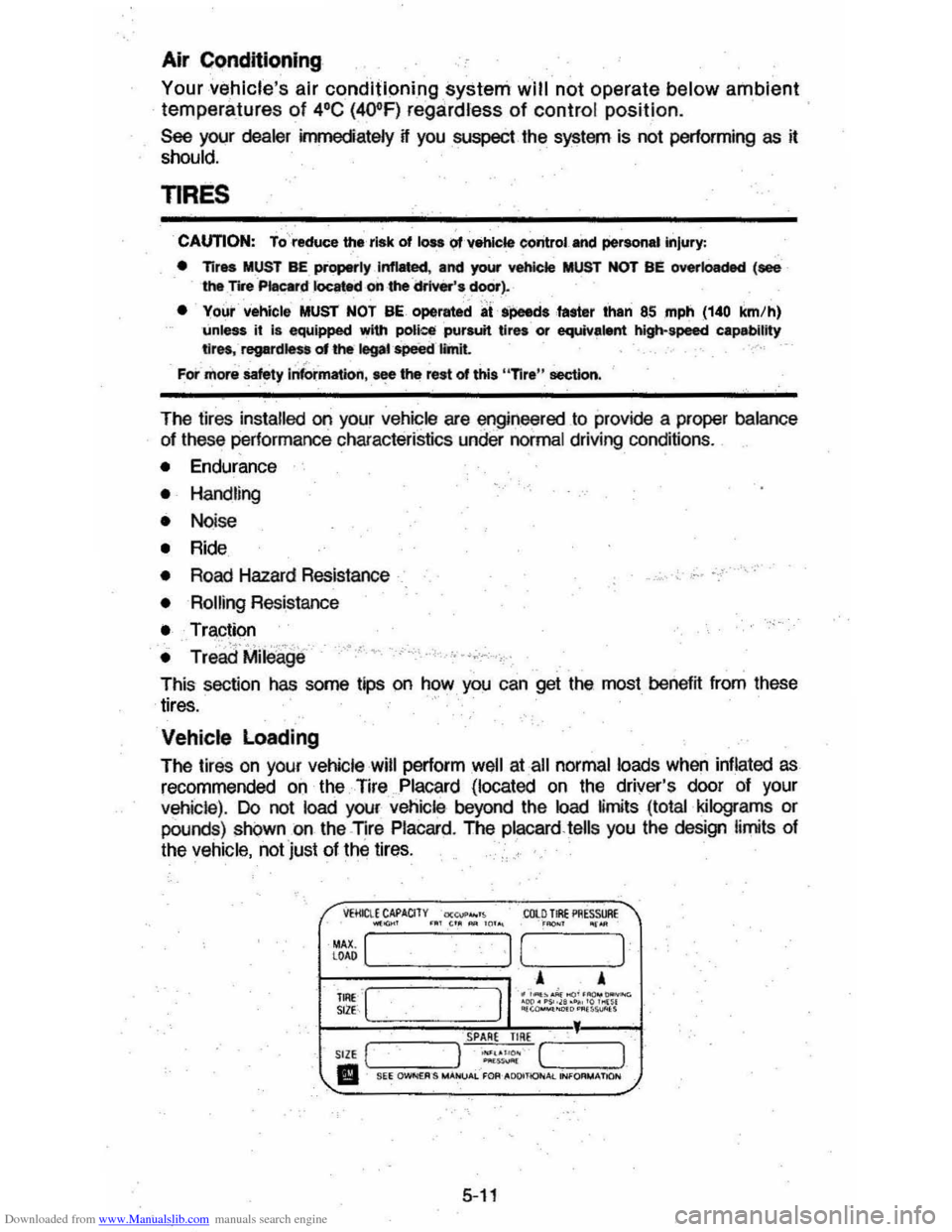
Downloaded from www.Manualslib.com manuals search engine Air Conditioning
Your vehicle's air conditioning system will not operate below ambient
temperatures of 4'C (40"F) regardless of control position. .
See your
dealer immediately H you suspect the system is not performing as it
should.
TIRES
CAUTION: T~\'reduce the 'risk of lose ~VehiCIe control and Person.1 injury:
• TTres MUST BE prOperly Inflated, .nd your vehicle MUST NOT BE overkMtded (see 1M r.e PtacM'.d _1Oc_.c:t on the driver's door).
• Voui" vehicle MUST NOT BE operated cti, lpeedsfaster than 85 mph (140 ~m/h) unless it Is equipped with poIi~ pursuit tires or equivalent high-speed capability ti,es.-regardhtss 01 the ~ speed lmtt.
For more Safety InfOrmation. ~ the rest or this " TIre" section.
The tires installed on your vehicle are engineered to provide a proper balance
of these performance characteristics under normal driving conditions.
• Endurance
• Handling
• Noise
• Ride
• Road Hazard Resistance
• Rolling Resi.stance
• Traction
• Tread Mile'age"' •... .... <.
This section has some tips on how you can get the most benem from these tires. '
Vehicle Loading
The tires on your vehicle will perform well at all normal loads when inflated as
recommended on the . Tire Placard (located on the driver's door of your vehicle) . Do not load your vehicle beyond the load Umits (total kilograms or
pounds) shown
on the·TIre Placard . The placard. tells you the design limits of
the vehicle, not
Just of the tires.
VEt«:lf CAP.l.CIl" DCGuI' ... " ,COLO Tff\E ffiESSURE ... _, ,., " •... 10'" ,_, "' ...
SPAR{ HR£
",,! " 1-::.:::(' 1 • SEE O~ S ~ANu ... i. FOR "'OI)IJ lQtjA,l INf-QAMATioN
5·11
Page 80 of 104
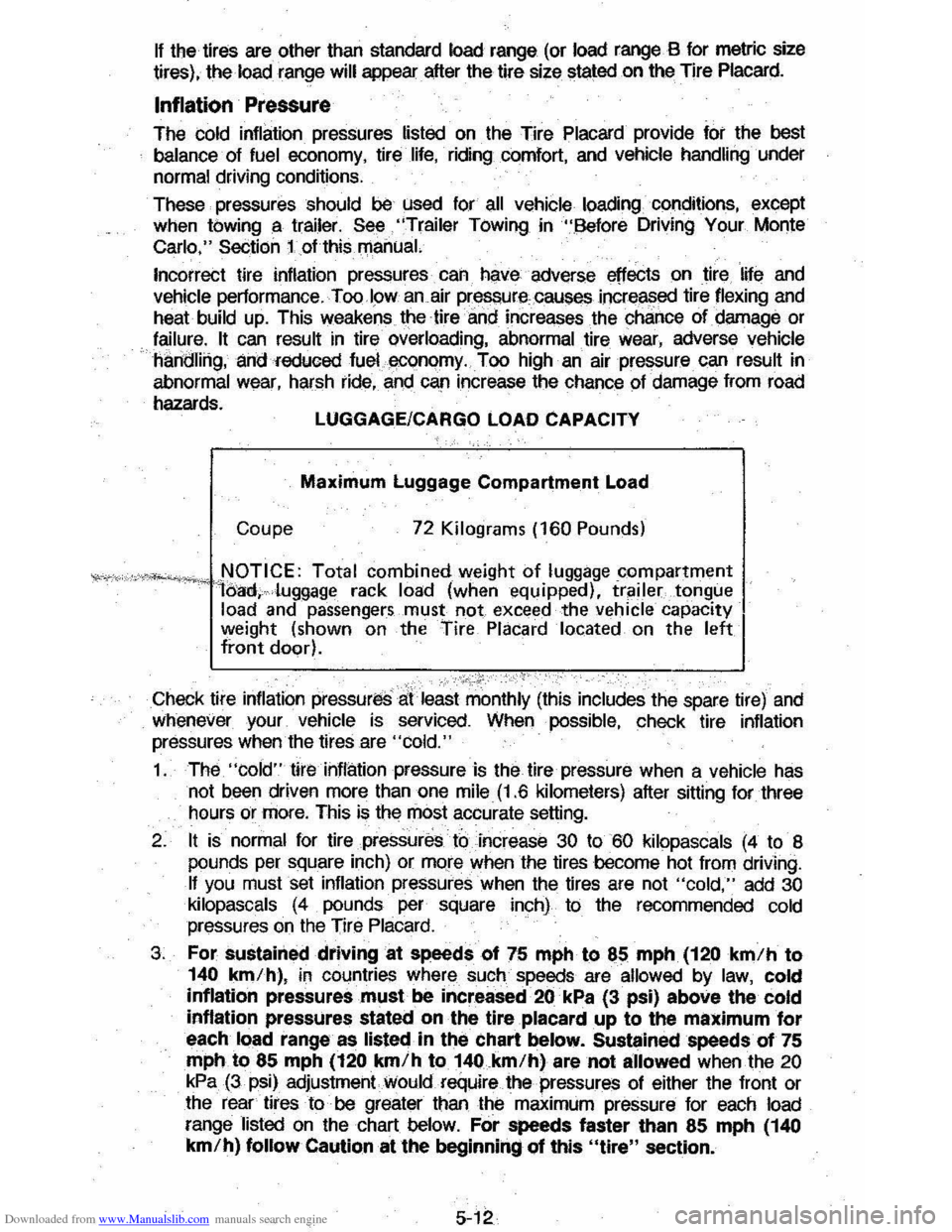
Downloaded from www.Manualslib.com manuals search engine If the tires are other than standard load range (or load range B for metric size
tires). the
load range will appear after the tire size stated on the Tire Placard.
Inflation Pressure
The Cold inflation pressures listed on the Tire Placard provide for the best
balance of fuel economy. tire life. riding comfort. and vehicle handling under
normal driving conditions.
These pressures
should be used for all vehicle loading conditions. except When towing a trailer. See. "Trailer Towing in "Belore Driving Your Monte
Carlo." Section 1 of this manuaL
Incorrect tire inflation pressures can. have adverse effects on tire. lije and
vehicle performance. Too low an air preS$urecaul>eS incre
abnormal wear. harsh ride. an.d can increase the chance of damage from road
hazards.
LUGGAGE/CARGO LOAD CAPACITY
Maximum Luggage Compartment Load
Coupe 72 Kilograms (160 Pounds)
"'"~~\"'_"~"""_'","",' NOTICE: Total combined weight of luggage _compartment 16ad •. ·.luggage rack load (when equipped). trailer tongue load and passengers must not exceed the vehicle capacity
weight (shown on the Tire Placard located on the left front door).
· ·' .L' Check tire inflation pressures at least monthly (this includes the spare tire) and whenever your _ vehicle is serviced. When -possible, check tire inflation pressures when'the tires are "cold."
1. The "cold" ttr~inflation pressure is the tire pressure when a vehicle has
not been driven more than one mile. (1.6 kilometers) after Sitting for three
hours or more. This is the most accurate setting.
2. It is normal for tire pressures to increase 30 to 60 kilopascals (4 to 8
pounds per square inch) or more when the tires become hot from driving. If you must set inflation pressures when the tires are not "cold," add 30
kilopascals
(4 pounds per square inch) to the recommended cold pressures on the Tire Placard.
3. For sustained driving at speeds of 75 mph to 85 mph (120 km/h to
140 km/h), in countries where such speeds are allowed by law, cold
inflation
pressures must be increased 20 kPa (3 psi) above the cold
inflation pressures stated on the tire placard up to the maximum for
each load range as listed in the Chart below. Sustained speeds of 75 mph to 85 mph (120 km/h to 140km/h) ar!! not allow!!d when the 20
kPa (3 psi) adjustment Would require the pressures of either the front or
the rear tiles to be greater than the maximum pressure for each load
range listed on the chart below. For speeds faster than 85 mph (140 km/h) follow Caution at th!! beginning of this "tire" section.
5-12